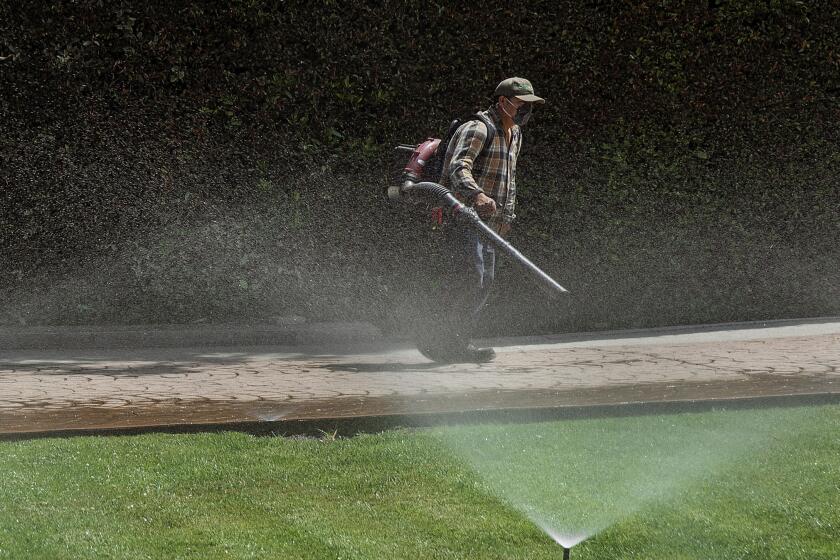With the cool of winter leaving plants dormant, it’s a good to time to
- Share via
No matter their size, great gardens start with one thing: a plan. If you want the garden of your dreams, you too must chart a garden course.
An important part of the planning process is to observe your yard, and a perfect time to do this is a quiet January day when some plants are dormant, says Maria Rodale, editor in chief of Organic Gardening Magazine, based in Emmaus, Pa.
“This month is a natural time to reflect and think ahead to the coming year and what you want to do in the garden,” Rodale says. “Sit down for at least a half an hour and really look at your garden. Notice what’s going on and how you feel about it. Taking the time to do this is what gives you those ‘aha!’ moments that are so critical to good garden planning.”
Spend a little time planning now, and you’ll save a lot of time later, she says. “Planning helps you avoid having to fix things that don’t turn out well, such as pulling up a plant that you put in the wrong place.”
Planning works best if you think in terms of two to four gardening seasons per year, and plot one to two seasons ahead, says Erik Katzmaier of Katzmaier Newell Kehr Landscape Architects & Architects in Corona del Mar.
When dreaming about the type of garden you want, it’s important to consider practical aspects, such as how much time you have for the garden, says Katzmaier, who recently completed a project at a home in Pelican Hills.
“If you want year-round color, do you have year-round time to maintain those plants and replant on a regular basis?” Katzmaier asks. “Or would something a little less labor-intensive be best? If you want rare plants in your garden, are you willing to take the time to raise them from seed, or do you have the money to buy them from specialty growers?”
“It’s important to be realistic about the geographic location and what will actually grow there,” says Rodale, author of “Maria Rodale’s Organic Gardening Companion: A Seasonal Guide to Creating Your Best Garden” (Rodale Books, $19.95, 2000).
Her easy-to-use garden planner-workbook is full of ideas and advice. There are areas for jotting plans and for listing plants and seeds to buy, as well as a seasonal checklist of chores to do in the garden.
Rodale created her guide because she feels that garden dreams are more likely to become a reality if they’re written down.
“The idea of turning a yard into an oasis can seem like an intimidating task, but if you write it down step-by-step, it loses some of its complexity and seems much more manageable,” she says. “The process of writing about the garden helps you organize your thoughts and make good plans. You also record your preferences, which you can refer to again and again.”
Writing down ideas in a garden plan also helps you connect the garden together as a whole, rather than thinking of it in separate parts, she says.
Lili Singer, a Van Nuys horticultural consultant, is another big believer in putting plans on paper.
“Often the worst mistakes people make occur when they plant things here and there in the yard, without planning ahead,” says Singer, editor of “The Gardener’s Companion, A Guide to Gardening in Southern California,” which will release its first magazine issue in the spring and will have a month-by-month garden planning guide.
“I like to work with graph paper while planning. I’ll play with the design, moving things around until I like what I see,” she says.
When planning, Singer suggests putting in trees and other permanent objects first, remembering to consider their mature size and how much shade they will eventually cast. This will help place larger plants so they don’t interfere with other plants or structures.
Group the plants by watering and exposure needs, and have a soil test conducted on several areas of the yard before planting.
Remember, though, that no matter how meticulous your plans are, nature has her way.
“Even the best garden designers change their plans, so be flexible and don’t expect 100% survival. Nothing in nature does that,” Singer says. “Also realize that even though you’ve carefully assessed a situation and location, a plant may just not want to perform in that spot. Gardening is an ongoing learning experience--even for experts--which is what makes it so fun.”
Resources
* “Maria Rodale’s Organic Gardening Companion,” (800) 848-4735, https://www.rodale.com.
* “The Gardener’s Companion: A Guide to Gardening in Southern California,” P.O. Box 3549, Van Nuys, CA 91407, (818) 780-5072. Subscriptions are $24 per year.
* “52 Weeks in the California Garden,” by Robert Smaus, (Los Angeles Times, $16.95, 1997), provides information on gardening in our climate.
* “Pat Welsh’s Southern California Gardening: A Month-by- Month Guide” (Chronicle Books, $24.95, February 2000) has checklists and information about what to do in the garden.






